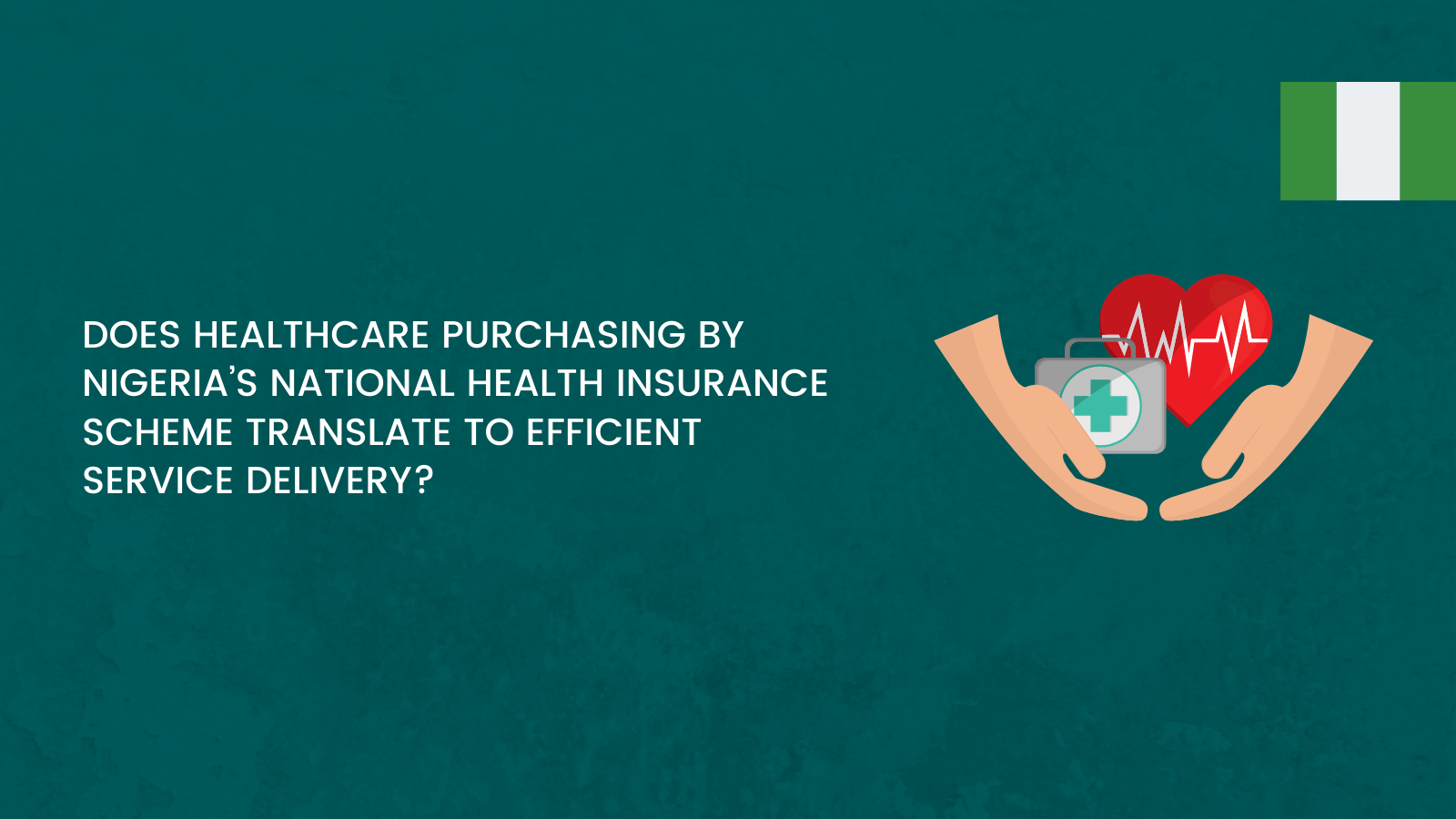“Price is what you pay; value is what you get”- Warren Buffett.
Social Health Insurance and Strategic Health Purchasing in Nigeria
In Nigeria, there are about 4.3% of Nigerians registered in one form of social health insurance programmes. The National Health Insurance Scheme (NHIS) is the agency responsible for social health insurance. It provides the primary purchasing function of setting guidelines and standards for the Social Health Insurance programmes in the country. NHIS also ensures accreditation of providers and Health Maintenance Organisations (HMO).
As simple as it sounds, NHIS’s mandate is to provide easy access to quality health care services and help achieve Universal Health Coverage (UHC) for the Nigerian population. As primary purchasers, the NHIS’s sources of funding include:
- enrollees’ premiums,
- grants received from federal, state and local governments,
- contributions from organized private sectors and international organizations,
dividends and interest on stocks and investments, and
- all other money which may accrue from time to time.
The HMOs, are engaged by the NHIS to serve other purchasing functions such as contractual arrangements with the service providers and effecting payments to them using provider payment mechanisms (PPMs). There are roughly 12,000 Health care facilities (HCFs) that provide service to the clients/enrollees of the scheme, and their aggregate distribution is 60% private and 40% public HCFs. To some extent, the public tertiary institutions and most privately owned facilities have an adequate level of autonomy in respect to resource utilization and decision making. In contrast, public primary and secondary health facilities have much less independence. They are directly answerable to their local government authority and state hospital management boards (SHMB), respectively.
Almost two decades after its inception, the NHIS has accumulated a commensurate operative ability. However, the enrollee expansion process has been a dilemma for the health insurance institution/regulator. Besides, there seems to be not well explored institutional governance arrangements between the purchasing agency and other stakeholders; hence the transformational mandate for its creation has been held down by its transactional capacities.
Lately, many LMICs are pursuing reforms to make purchasing for health care services more strategic. The goal is to improve the quality of health care goods and services delivered, as well as to incorporate efficiency in health spending and promote equity in the health system. Nigeria seems to have joined the train, but is yet to see far-reaching results in service delivery outcomes. Strategic purchasing, as against ‘passive’ purchasing, may constitute an appreciable remedy in this regard. Hence, strategic health purchasing is likely to help yield significant service delivery results and health systems goals. Strategic purchasing, through well-coordinated purchasing functions, generates financial incentives for service providers, and this allows them to contribute positively to health systems goals. Thus, this blog provided information on how healthcare purchasing in Nigeria’s NHIS affects intermediate and service delivery outcomes.
Healthcare Purchasing and Strategic Health Purchasing Functions
Ideally, purchasing in healthcare relates to obtaining the health services needed by a person, group or population segment, from a responsible service provider. This service provider, in return, receives corresponding or established payments for services rendered. Healthcare purchasing denotes activities, such as provision and availability of services; demand and payment for services; as well as the regulation of utilization of services for quality and responsiveness. Purchasing becomes strategic when there is ‘active, evidence-based engagement in defining the service-mix and volume and selecting the provider-mix to maximize societal objectives’.
Thus, it involves what to buy (specification of health services), from whom to buy (choice of providers) and how to buy (payment mechanisms). ‘Purchasing functions’ is a term used to describe components of these planned choices. In contrast, purchasing is passive if poorly designed, and non-evidenced based processes encumber above arrangements. Cheryl Cashin and Nathaniel Otto of R4D break these concepts down to the basics here.
Current Provisions for Healthcare Purchasing in NHIS
The NHIS as a purchaser has an explicit purchasing mandate clearly defined in its operational guidelines. There is a benefit package for each vertical social health insurance programme. The benefit package review should come up every two years. However, the NHIS performed this only twice in fourteen years. The challenges of getting all stakeholders to agree on both principles and criteria for the review seemed to be the labour. Relatedly, there are growing concerns by enrolees who want their benefit package expanded. Accessibility of drugs in the NHIS vertical programmes requires a cost-sharing of 10% of total medicines prescribed per visit while there is a 50:50 co-insurances for some diseases on partial exclusion.
The NHIS applies a non-selective approach to contracting facilities that participate in social health insurance services. Contracting is open to both private and public facilities or providers that meet specified criteria. There is no difference in the accreditation requirement between the public and private sectors. This contract is usually for a two-year term in the first instance, then three-year terms afterwards. There are specific contracting modalities, including facility and personnel requirements for different levels of care. Contracts may be terminated for gross violation of the contract terms as contained in NHIS operational guidelines.
PPMs in use are capitation and fee-for-service. HMOs, as third-party administrators, have the responsibility to transfer these payments to the providers for client services rendered at their facilities. How these payment mechanisms are transmitted to service providers, including lateness or arbitrary shortages in service repayments have been shown to motivate different provider behaviours, and consequently affect the enrolees directly or indirectly. As is usually experienced in Nigeria, the loose synchronization of PPMs produces some adverse actions. Fee-for-service, encourages overzealous (high intensity) care that is not necessarily high-value while capitation to primary care, in contrast, encourages rationing of services.
Health Purchasing in NHIS and Service Delivery Outcomes
Purchasing and provider incentives play a large role in improving equity and quality, especially around streamlining continuum of care and enhancing the level of attention and detail given by providers to their clients. But, for now, there is no evidence that funding allocations and payment to providers reflect population health needs. Likewise, little progress has occurred to ensure that funds do not concentrate in wealthy urban areas. However, this is one of the equity anomalies that the basic health care provision fund (BHCPF) seeks to address.
Also, there is the non-inclusion of public primary health centres in the National Health Insurance Scheme mainly because of unavailability of doctors/registered nurses staffing these centres (thereby causing geographic disparities to use of and access to facilities). Other issues are out-of-stock syndrome for generic drugs, ineffective use of health technologies, and the erroneous emphasis of processes on curative rather than preventive care.
What We Recommend
Strategic as against passive purchasing can be the only remedy to yield significant improvement in service delivery results and health systems goals.
The following are our recommendations:
- Intensifying evidence creation and co-creation activities around strategic health purchasing among HPSR researchers and other diverse actors in the healthcare financing space, to inform policy learning and action.
- Advocacy and awareness creation on the need for SHP among policy actors and programme staff within the SHI purchasing value chain (Ministries and agencies involved, HMOs and provider network) should be entrenched.
- Embedding capacity building endeavours such as training, mentoring and cascading among national, zonal and state level NHIS operational units.
- Massive recruitment and capacity building of human resources for health in public primary health facilities and their subsequent inclusion in NHIS’s service delivery to improve quality, access, and equity in population health care delivery.
- Deployment and use of up-to-date information and other health technologies by the NHIS, HMOs and service providers to ease information and data management as well as other purchasing activities.
- Timely review of benefits package in the SHI vertical programmes to reflect an evidenced pattern of need and use of services.
Harmonization of the PPMs in such a way to diminish the commonly encountered adverse incentives.
AUTHORS

Dr Chikezie Nwankwor is a lecturer at the Department of Health Administration and Management, University of Nigeria, Enugu Campus where Chikezie lectures postgraduate students in Health Policy and Systems and Health Services Management modules. He is also a research associate at the Health Policy Research Group (HPRG).

Uchenna Ezenwaka is a research associate at the Health Policy Research Group (HPRG), College of Medicine, University of Nigeria Enugu Campus. She has a keen interest in the field of health policy and systems research in Nigeria – analysis of health policies, health services research including maternal and child health interventions, and getting research evidence into policy and practice and implementation research including adolescents’ health. She is a member of the health system global (HSG) and the West African Network of Emerging Leaders (WANEL).

Professor Benjamin S.C. Uzochukwu is a Public Health Physician at the University of Nigeria Teaching Hospital Enugu and Professor of Public Health, Health Policy and Systems, University of Nigeria, Nsukka where he was the founding Director of the Institute of Public Health. He is the National President of the Association of Public Health Physicians of Nigeria (APHPN), Director of Grants and Research West African College of Physicians (WACP) and member of the Ministerial Expert Advisory Committee on COVID-19 Health Sector Response (MEACoC).

Dr Uchenna Ewelike is a Senior Health Economist and Assistant General Manager working with the National Health Insurance Scheme (NHIS), Nigeria. He is the author of the book, “Basics of Health Financing in a Developing Economy”, a health financing book used in teaching students and residents doctors in about 22 Universities in Nigeria. He is an active member of Joint Learning Network for Universal Health Coverage, where he has participated in the development of two knowledge products. Ewelike member of the Health Policy Research Group (HPRG) in Nigeria.

Obinna Onwujekwe is a Professor of Health Economics, Systems and Policy, and the Director of the Directorate for Research in the University of Nigeria, Nsukka. He is the founder and Director of the Health Policy Research Group, which is a renowned and reputable research organization. He has led the development of many health policies in Nigeria, including the National Health Policy (2016) and the National Health Financing Policy (2016). He has served on the scientific and advisory boards of the African and International Health Economics.

